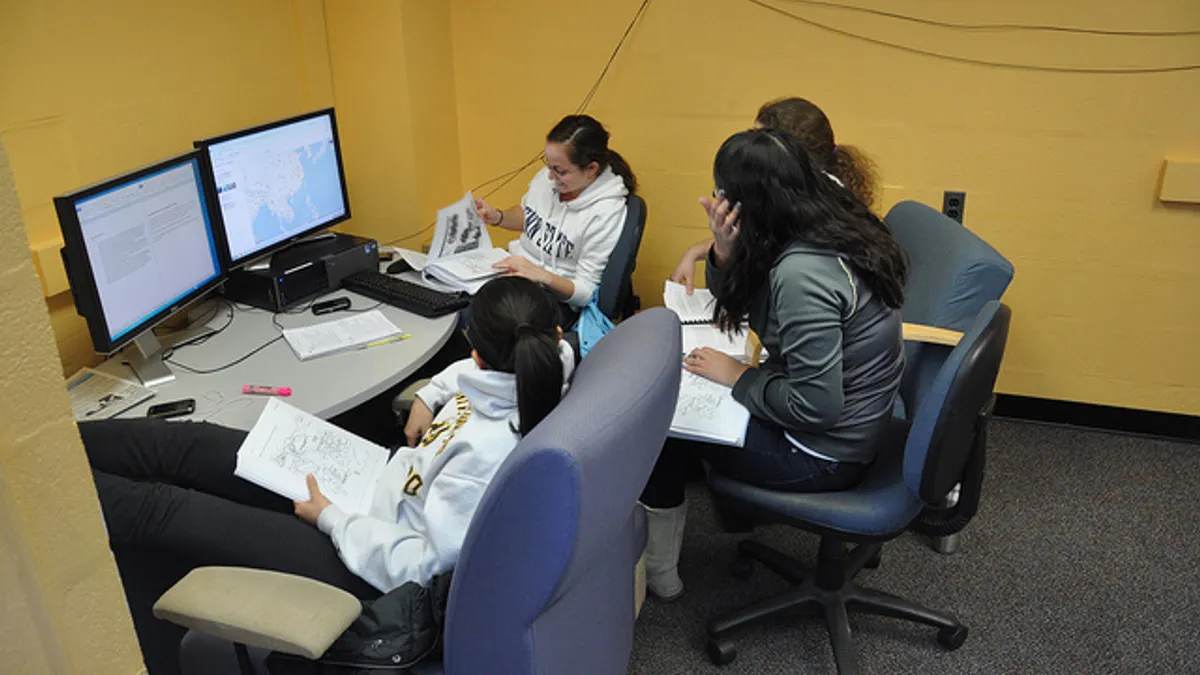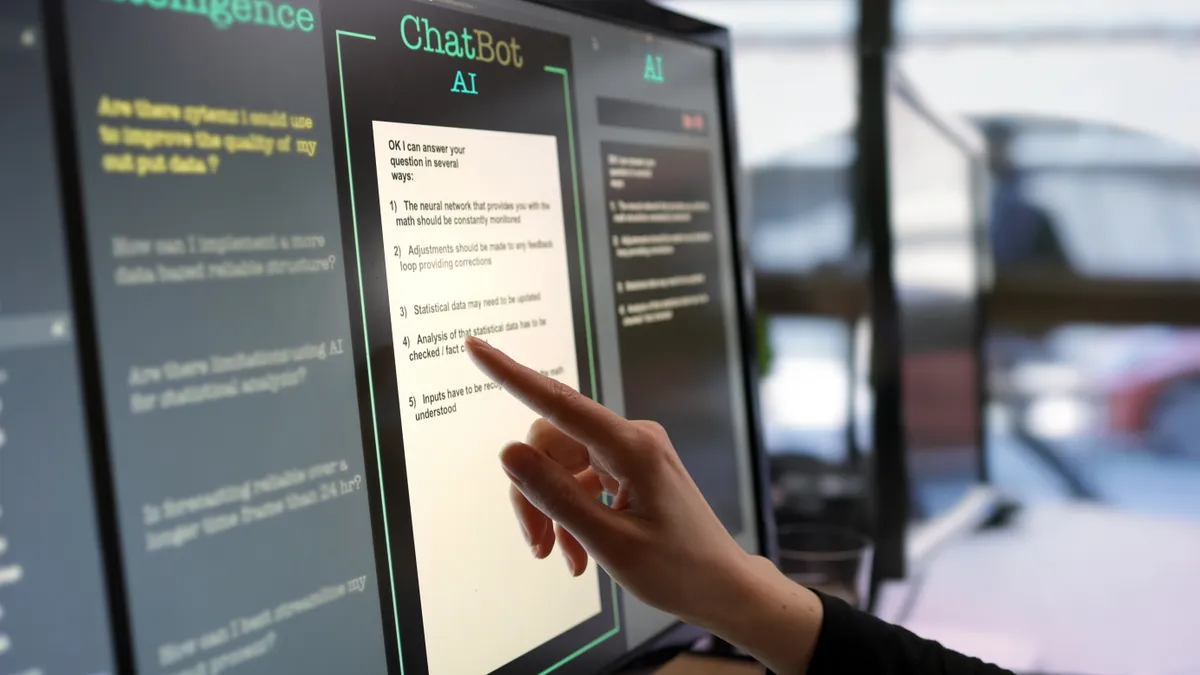Blended learning—which combines traditional, face-to-face instruction with technology-based learning—is considered by some to be education’s next big thing. Salman Khan has made a name for himself with the method through his Khan Academy, which is used in around 15,000 classrooms to augment the learning experience.
Many school districts and even colleges have shown improvement when blended learning is implemented, with some underperforming schools even performing complete turnarounds. This year, Education Dive has already compiled case collections of iPad classroom projects and flipped learning uses. Today, we break down 13 examples of how blended learning’s proliferation has made an impact at various levels nationwide:
1. VIRTUAL PARTICIPATION AT MULTIPLE SCHOOLS
Where: Manchester School District, N.H.
Manchester Superintendent Thomas Brennan’s “Maximizing Educational Opportunities” report presents a plan for blended classrooms where students can complete courses through the Virtual Learning Academy Charter School and “remote classrooms” that would allow students to virtually participate in courses at any one of the district’s three high schools. Additionally, students would be able to take college courses through the University of New Hampshire-Manchester.
2. ALTERNATIVE ASSIGNMENTS IN FAILURE CASES
Where: New York City “turnaround” schools
Earlier this year, New York teacher Sam McElroy blogged about a year of blended learning under the iLearn NYC Program. The Department of Education initiative gives New York City schools access to reduced-cost online content, a learning management system for hosting online courses, and professional development, tech support and training. In his blog, McElroy mentions that blended learning has been controversial in the city due to its use in credit recovery programs, which allow students to complete alternate assignments in exchange for credits in classes they failed.
3. SELF-DIRECTED LEARNING AND PROFESSIONAL TRAINING
Where: University of Central Florida, Orlando, Fla.
Dr. Kathie Holland has applied blended learning to her fourth-year undergraduate management course focused on training and development activities. Using self-directed reading, online learning modules and assignments, face-to-face lecture and participative activities (both on- and offline), her students learn how to approach situations from a managerial point of view and understand human resource development practices. The Blended Learning Toolkit, a website prepared in part by UCF, also lists two other courses at the school among its examples.
4. HYBRID COURSES
Where: University of Wisconsin-Milwaukee, Milwaukee, Wis.
UWM lists several courses in its Colleges of Nursing and Business Administration, and Departments of Anthropology, English and Visual Arts as “hybrid” courses. Various portions of these courses occur online or off-campus, though all six maintain a face-to-face component. In-depth analysis and practical field assignments are also emphasized in several of the course descriptions.
5. REDUCE DROPOUT RATES
Where: Alexandria, Va.
Alexandria City Public Schools was among five districts that received awards at the International Association for K-12 Online Learning’s Virtual School Symposium in October for using blended learning to boost graduation rates. Virginia’s Department of Education identified Alexandria’s T.C. Williams High School as a “persistently low achieving” school in 2010. With Online Learning Coordinator Mary Fluharty’s guidance, the school has adopted a full program of online courses, launched the T.C. Satellite Campus this fall, lowered its dropout rate and sent 84% of last year’s graduate to college.
6. TEACH ENGLISH LITERATURE
Where: Windsor High School, Windsor, Calif.
Catlin Tucker, a Google Certified Teacher and CUE Lead Learner who teaches freshman and sophomore English language arts, is so invested in blended learning models, she’s written a book titled Blended Learning for Grades 4-12: Leveraging the Power of Technology to Create a Student-Centered Classroom. On her personal website, she blogs about her blended teaching strategies and suggests her favorite Web tools, including Collaborize Classroom, Evernote and Google Docs. Her most recent post details how she prompted students to explore the relationship between language and cultural identity while reading Ray Bradbury’s Fahrenheit 451.
7. INTERGRATE COLLEGE PREP COURSES IN HIGH SCHOOLS
Where: iPrep Academy, Miami, Fla.
Flex schools such as Miami Dade’s iPrep Academy are described as small, individual schools with an online curriculum, which allows students to move at their own pace and compliments online work with projects, tutoring and practical learning. iPrep sites serve over 800 students at nine Miami Dade high school campuses and allow students to take college prep and college-level courses, and to take part in internships and community service projects. Additionally, the district offers learning labs where students can “self-blend” by enrolling in online courses for part of the day.
8. GROW NEW LEARNING MODELS FROM THE GROUND UP
Where: Venture Academy, Minneapolis, Minn.
When Venture Academy opens in 2013, it will be Minnesota’s first blended learning middle-high school. The public charter school’s founders, Jon Bacal and Kerry Muse, believe the blended learning model will “catalyze major systemic change” in education and want to hire what they call “edu-preneurs”—teachers with the versatility, creativity and adaptability to help inspire students through personalized and experiential learning. If the blended learning model shows success at the first school, the duo plan to open more Venture campuses.
9. INTRODUCE STUDENTS TO TECHNOLOGY
Where: Concordia University Wisconsin (Mequon, Wis.)
This month, Concordia University Wisconsin opened its Center for Excellence in Learning and Teaching with the goal of developing faculty prepared for both traditional face-to-face and blended learning environments. Equipped with a state-of-the-art teaching and learning lab, faculty can practice technology prior to using it with students.
10. TAILOR LEARNING PACES TO STUDENT NEEDS
Where: Scottsdale, Ariz.
This year’s first-ever Arizona Blended Learning Summit happened earlier this month and was designed to increase dialog on the topic in the state of Arizona and beyond. In addition to individual presenters, Vail School District, which implemented an online program allowing students to take e2020 courses at their own pace, was among three Arizona schools at the summit presenting their experiences with technology-based curriculum. According to data from the 2011-2012 school year, 80% of the Vail district’s courses were completed and administrators saw an increase in high school graduates.
11. ADDRESS MULTIPLE MATH SKILL LEVELS
Where: Rainier and Tahoma Summit Charter Schools, San Jose, Calif.
Opening last year, Summit Rainier and Tahoma utilized their one-to-one computer program to experiment with blended learning, using Khan Academy videos for math instruction. Teachers introduce students to a concept, and the students complete practice exercises through Khan Academy. Teacher Zack Miller says the model made it possible to provide high-quality targeted instruction, but the varying skill levels was a struggle. This year, the school built one large math room that fits 200 students, with smaller rooms for assessments, projects and tutoring.
12. "CHALLENGE TIME"
Where: Crocker Highlands Elementary, Oakland, Calif.
Fourth grade teacher Ashley Foster, whose students work once a week with ALEKS math software during lab time, is working to find more ways to infuse her direct instruction with online learning. Some of her fourth-graders are now doing fifth-grade math on ALEKS, leading her to send students with a strong grasp on a concept out to the hall for “challenge time”—advanced word problems requiring critical thinking. Those concepts have become a goal for the other students, however, and they now view “challenge time” as a reward for understanding the material.
13. FACILITATE ONLINE DISCUSSIONS
Where: Simmons College, Boston, Mass.
Simmons College, a women’s liberal arts school in Boston, has a website devoted to blended learning and featuring several case studies with various faculty members discussing their experiences with the teaching method. Madalaine Pugliese’s case study, for example, details how she planned to transition her course, Differentiated Instruction using Technology across the Curriculum, to a blended model, detailing planning and organizational strategies. Other case studies discuss how to set up online student groups and how to facilitate online discussions.
Would you like to see more education news like this in your inbox on a daily basis? Subscribe to our Education Dive email newsletter! You may also want to read this list of 16 flipped learning uses in K-12 and college classrooms.








 Dive Awards
Dive Awards














